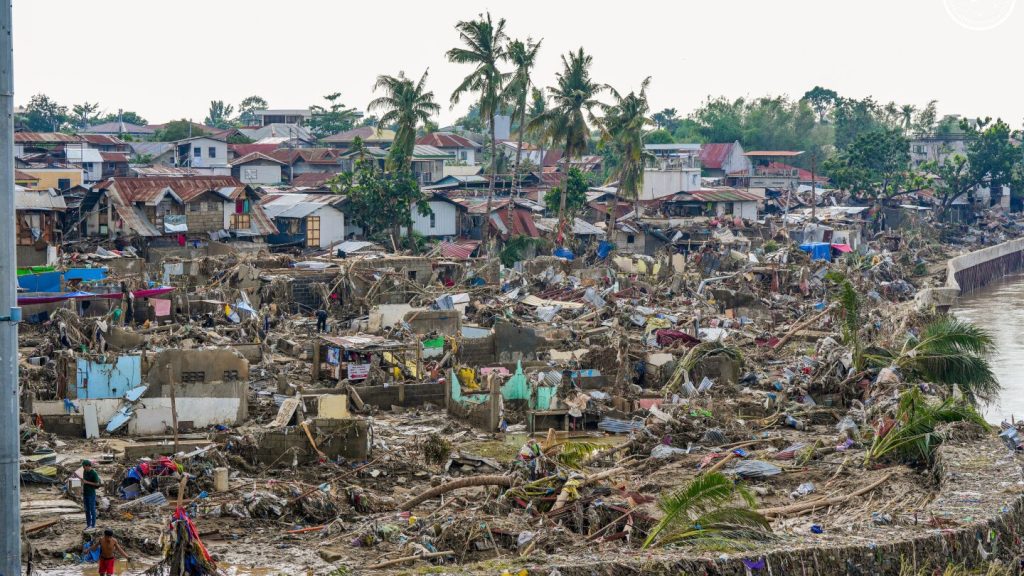Listen to the article
Typhoon Kalmaegi killed at least five people in Vietnam on Friday, bringing destructive winds and torrential rains that flattened homes, blew off roofs, and uprooted trees across the country’s central provinces. The storm’s impact comes just days after it devastated the Philippines, where the death toll has reached at least 204, with another 109 people still missing.
In Vietnam’s Dak Lak and Gia Lai provinces, residents began clearing debris and repairing damaged structures as the storm moved on. The disaster demolished 52 homes and damaged nearly 2,600 others, with Gia Lai province alone reporting more than 2,400 structures affected. The storm caused widespread power failures, knocking down hundreds of power poles and cutting electricity to more than 1.6 million households. While authorities have restored service to many areas, about 500,000 homes remained without power as of Saturday.
The industrial impact has been significant, with factories in Binh Dinh province losing their roofs and suffering equipment damage due to flooding. In Quy Nhon, one of the hardest-hit cities, residents gathered at a shopping mall—one of the few places with backup power—to charge their devices and contact relatives.
In the Philippines, the devastation has been even more severe, particularly in Cebu province, where 141 people perished in flooding. The human toll was captured in the story of Jimmy Abatayo, who lost his wife and nine close relatives to the typhoon.
“I was able to swim. I told my family to swim, you will be saved, just swim, be brave and keep swimming,” recalled Abatayo, 53, before breaking into tears. “They did not hear what I said because I would never see them again.”
Throughout Cebu, villagers gathered to mourn their dead, with local gymnasiums transformed into makeshift funeral parlors. White coffins lined with flowers and portraits of the deceased served as stark reminders of the disaster’s human cost.
The Philippines remains under a state of national emergency declared by President Ferdinand Marcos Jr., who visited Cebu on Friday. During his visit, Marcos explained that an unusually large volume of rain had overwhelmed flood control systems, causing rivers to rapidly overflow and flood nearby communities. The disaster has displaced more than half a million people, with nearly 450,000 evacuated to shelters and about 400,000 still unable to return home.
The Philippines now faces the threat of another powerful storm, Typhoon Fung-wong (locally known as Uwan), expected to make landfall late Sunday or early Monday in northern Aurora province. The approaching typhoon could potentially affect Manila, the country’s densely populated capital region.
In Vietnam, authorities evacuated around 100 households in Lam Dong province as a precaution after discovering leaks in an irrigation dam. Meanwhile, in Ho Chi Minh City, Vietnam’s financial hub, residents waded through flooded streets as high tides and lingering rains from Kalmaegi inundated low-lying neighborhoods.
The back-to-back disasters highlight the increasing vulnerability of Southeast Asian nations to extreme weather events. Vietnam, which typically experiences about a dozen storms annually, has been hit by a relentless series this year. After Typhoon Ragasa dumped torrential rain in late September, the country endured Typhoon Bualoi and Typhoon Matmo, which together left more than 85 people dead or missing and caused an estimated $1.36 billion in damage.
Climate scientists warn that these intensifying weather patterns are consistent with global warming trends. Kristen Corbosiero, a professor of atmospheric and environmental sciences at the University at Albany, noted that this has been an above-average year for storms, with Kalmaegi and Fung-wong representing the 26th and 27th named storms in a season that typically sees 23 by this time.
“If you look at the climatology for the Philippines and for Vietnam, it’s almost the entire year that they can get them because the warm waters that fuel the storm just are there,” Corbosiero explained.
As recovery efforts continue in both nations, the human and economic costs of these increasingly frequent and destructive weather events continue to mount, challenging the region’s resilience and disaster response capabilities.
Fact Checker
Verify the accuracy of this article using The Disinformation Commission analysis and real-time sources.




7 Comments
The scale of the damage is a stark reminder of the vulnerability of communities in the face of powerful natural disasters. Strengthening infrastructure, improving early warning systems, and enhancing disaster risk reduction measures should be top priorities.
The impact on the mining and industrial sectors in the affected regions is likely significant. I wonder how this will affect commodity supply chains and prices in the coming months as the cleanup and rebuilding efforts continue.
The devastation caused by Typhoon Kalmaegi is truly concerning, especially with the impact on homes, infrastructure, and businesses in Vietnam. It’s critical that recovery efforts provide aid and support to the affected communities as they work to rebuild.
It’s distressing to see the human toll of this typhoon, with lives lost and many still missing. My heart goes out to the people of Vietnam and the Philippines as they grapple with the aftermath and work to recover.
The widespread power outages and damage to industrial facilities highlight the importance of investing in more resilient and sustainable energy infrastructure. Renewable energy sources could help mitigate the impact of such storms in the future.
This storm serves as a sobering reminder of the increasing frequency and intensity of extreme weather events due to climate change. Strengthening disaster preparedness and resilience measures will be crucial for vulnerable regions like Vietnam and the Philippines.
With another storm on the way, the Philippines will need to draw on all available resources and expertise to prepare and respond effectively. Coordinating relief efforts across the region will be crucial in the days and weeks ahead.